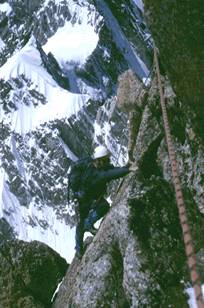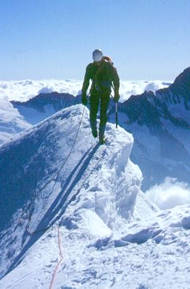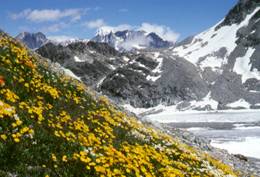| |
|
Addressed particularly to British
climbers and mountain lovers, these articles discuss what
to expect from climbing and mountaineering in the Alps –
this three part series discusses scale, altitude, mountain
weather, descents, glaciers avalanches and more ...
|
|
|
A Beginner's Guide to Alpine Mountaineering
– Part 1
Rob Collister, a qualified UIAGM/IFMGA Mountain
Guide for thirty years, discusses mountaineering in the Alps from
the perspective of the beginner mountaineer / climber, perhaps graduating
from experience in Wales, the Lakes or Scotland where a visit to
the Alps is the logical next step – the big hills beckon.
 Alpine
scale Alpine
scale
Alpine climbing looks deceptively glamorous in the photos. What
disconcerts many British climbers on their first visit to the Alps
is the sheer effort involved. The three-hour walk up to a hut with
a heavy pack, the need to be on the move before daybreak to ensure
good snow conditions or simply sufficient time, and a day which
will be a minimum of six hours sustained movement, will often be
twelve and, if things go wrong, may be much longer, all combine
to make it a strenuous pastime. (On one memorable occasion we left
a hut at midnight to return exactly 24 hours later, having been
on the move the whole time and, to rub salt in the wound, having
failed to complete our route.)
To a large extent physical attributes determine who
enjoys the Alps. Some revel in 'the magic of long days', the utter
content that comes at the end of an exhausting climb, the rewards
in proportion to the effort expended. Others are more suited to
the bursts of explosive energy needed in high-standard rock-climbing,
and for them the steady rhythm – plod, some would call it –
of an alpine climb, holds few attractions. However, whatever type
you are, fitness is essential if you are to enjoy an Alpine holiday,
and the fitness that comes from hill-walking or running will be
of more use than weight training or climbing wall fitness. Even
starting from a high hut, the majority of alpine climbs are far
longer than anything we have in Britain, and on top of that there
is the debilitating effect of altitude.
Altitude
 Altitude
is something one can do little to prepare for. It is common to suffer
from a headache and loss of appetite the first night in a hut, and
unless you want to feel thoroughly miserable you will not choose
a 4000m peak for your first route. But most people acclimatise fairly
quickly and after a few days it ceases to be a problem. The rate
of acclimatisation does vary with individuals, though, and bears
to no relation to fitness. Altitude
is something one can do little to prepare for. It is common to suffer
from a headache and loss of appetite the first night in a hut, and
unless you want to feel thoroughly miserable you will not choose
a 4000m peak for your first route. But most people acclimatise fairly
quickly and after a few days it ceases to be a problem. The rate
of acclimatisation does vary with individuals, though, and bears
to no relation to fitness.
A few unfortunates simply cannot adjust at all to
the reduced amount of oxygen available, even at relatively low altitudes.
For them Diamox might be the answer. But otherwise, it is better
not to tamper with your body's chemistry. I question the trend towards
using Diamox as a matter of course on expeditions; it is, after
all, using a drug to improve performance which seems a dubious practice,
frowned on in most sports.
Mountain weather
Another important factor in the Alps is the weather. In Britain,
even in winter, weather is usually just something we put up with.
But in the Alps, storms can be so violent that you can move neither
up nor down. More commonly, rock-climbs become plastered with snow
in minutes, making them desperate, if not impossible. And electric
storms, originating as convection clouds over the plains, are common
in the afternoons, even in good weather. Few things are more terrifying
than being on a high ridge, static electricity buzzing all around,
knowing you are a prime candidate for the next lightning strike.
Because routes are long and the weather rarely
settled, speed comes to mean safety. It is necessary to forget the
casual, laid back approach of British crag-climbing and cultivate
a sense of urgency. Not for nothing do the French refer to the start
of a climb as 'l'attaque'. Chiefly, this is a frame of mind, a determination
to 'get up and go' but technically it is expressed by moving together
with a shortened rope and a handful of coils wherever feasible,
rather than climbing pitch by pitch. Coils are dropped or taken
in to avoid holding each other up, partners keeping a runner between
them on exposed ground and taking direct belays around rock spikes
to protect one another on anything awkward and moving on with a
minimum of fuss or time loss. It is a technique calling for constant
vigilance and it is not easy to do well, but it is a skill well
worth developing.
Descents
Climbing down is another skill we do not practise in Britain. Even
when they have made good time on a climb, most British parties will
be left behind by Continentals on the descent. It is also the most
dangerous part of the day. Rock descents are often down couloirs
vulnerable to stone-fall started by other parties, so speed is important.
Snow will be soft, but overlying ice, and crampons will be balling
up (anti-balling plates are worth their weight in gold here). Just
when mind and body want to relax and let go after the tensions of
the climb, you have to concentrate harder than ever.
Abseils are particularly dangerous. The weak
link is usually the anchor, so commando-style leaps which look impressive
but shock-load the anchor are a bad idea. Unless descending an ice
slope or a vertical wall, it is worth using a single rope and keeping
abseils short. The longer they are, the greater the chance of a
loop catching round a spike, or the knot joining the two ropes jamming
in a crack. Always test in situ pegs, and preferably back them up
for the first person down. Be very suspicious of old abseil slings.
Every time a rope is pulled through a sling it burns a groove in
it and, in addition, nylon is susceptible to ultra-violet light
and deteriorates rapidly at altitude. It makes sense to carry a
length of 6mm cord and cut it as and when you need it. It is a good
idea to tie a knot in the end of the doubled rope, so there is no
chance of sliding off the end of it. If you are the first person
down an abseil, belay yourself before coming off the rope, preferably
out of the line of fire of rocks dislodged by the rope or your partner.
Then pull one end of the rope to make sure it can be retrieved.
There is nothing more frustrating, time consuming and potentially
expensive than a jammed abseil rope.
Why do it?
 No
climb is over till you are finally off the glacier. But, to quote
Arnold Lunn, who was a keen climber until he broke his leg on Cyfrwy
Arete on Cadair Idris and became more interested in skiing,
'No moments are more wholly satisfying than
those which follow the safe return to easy ground'. No
climb is over till you are finally off the glacier. But, to quote
Arnold Lunn, who was a keen climber until he broke his leg on Cyfrwy
Arete on Cadair Idris and became more interested in skiing,
'No moments are more wholly satisfying than
those which follow the safe return to easy ground'.
If I seem to be dwelling on the dangers and discomforts
of Alpine climbing, it is because the Alps are more dangerous and
more tiring than our own hills, even Scottish ones in winter. Yet
the rewards are great too. There are instants of sheer joy, as when
you find a trickle of pure cold water halfway up a sun-baked rock
spire, or pull round a corner to find the deep, vibrant, stained
glass blue of King of the Alps in front of your nose, or when, after
hours of shivering on north-face stances watching sunlight creep
towards you, finally you climb into its warmth as into a loving
embrace: these are the moments which last a lifetime. And there
is the time of which Lunn speaks, stretched out in a flowery meadow,
or allowing gravity to carry you down the zig-zags of a well-made
path, when the world is a marvellous place and it seems that
'all shall be well, and all manner of things shall be well'.
Part 2: Glaciers
and avalanches >>
Text © Rob Collister
and travel-quest 2006, all photos © Rob Collister
2006
|

